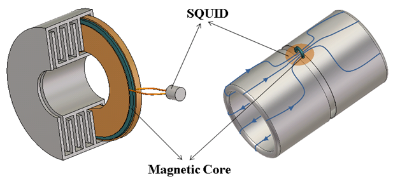Absolute Beam Current Measurements

The low-energy, low-intensity, antiproton beam obtained in the Antiproton Decelerator (AD) and the future Extra Low ENergy Antiproton (ELENA) storage rings at CERN have an average current in the range of few 10's uA to 0.1 uA, which is bellow the sensitivity of DC Current Transformer's current monitors. Additionally during the beam cooling phases, the beam is operated in a coasting beam (DC) mode, making it impossible to be measured with usual fast Current Transformers.
These beam parameters require an increased sensitivity and resolution in beam intensity measurements in order to optimize the machine operation, and ultimately increase he number of antiprotons delivered to the experiments.
Non-perturbing beam current monitors usually rely on sensing the magnetic field created by the traveling beam. The limiting factor of the measurement is the noise, either in the sensing device, the processing electronics or coupled from external noise sources. With the current intensities observed in the AD and ELENA rings the magnetic field in the measurement region will be of the order of pT's which is 7 orders of magnitude smaller than the Earth's magnetic field.
Various laboratories have shown the potential of using superconducting shields to suppress all the undesired magnetic field components and sources, while leaving unchanged the magnetic field created by the beam. Together with a Superconducting Quantum Interference Devices (SQUIDS) working as a very sensitive magnetometer it is possible to overcome the limitations mentioned earlier. These devices can provide a measurement dynamic range exceeding 80 dB and have enough resolution to measure beams down to the nano‐Ampere level. Within this project a current measurement device shall be developed with a resolution below 10nA, and a bandwidth of 1kHz. The design shall be adapted to be installed in the AD and ELENA rings at CERN.
During the first phase of the project we surveyed similar projects conducted by other groups, and investigated which superconductor technology (low- or high-temperature) was the most suitable to fulfill the desired specifications. We concluded that a device based on low-temperature superconductors was the only option to achieve the desired current resolution. We then looked into an adequate location for installation of the new current monitor in both accelerators, what was followed by a study of the expected background magnetic field (coming from the accelerator magnets) in this places. Simulation of different shielding structures were conducted which confirmed the theoretical predictions, as well as the simulation work conducted by other groups. Currently we are working on defining the best solution for the cryostat design that will be needed to house and cool down the superconducting parts of the current monitor. Final design of the cryostat will be done by the Cryogenics group at Cern.